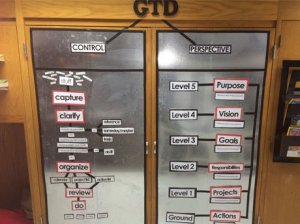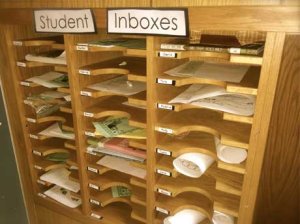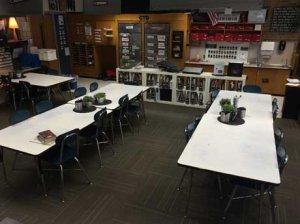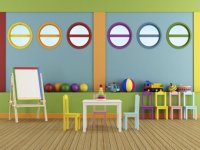Elementary School Children are “Getting Things Done”
Busy, distracted, sleepless, anxious, stressed . . . overwhelmed. Sound familiar? Over the past few decades, we have moved from the industrial age of linear work to the dynamic multifaceted age of knowledge work -- with more information and stimuli than ever before. Feeling lost and pressured is a unique knowledge work phenomenon, but one that can be relieved.
In 2008, I was introduced to David Allen's book Getting Things Done: How to achieve stress-free productivity, and found my life changing for the positive -- increased stability and control, higher engagement in the present, and an increased desire to take creative risks in my teaching practices.
What is Getting Things Done (GTD)?
GTD is a systematic approach to:
- Obtaining control and stability
- Capturing anything and everything that has our attention
- Making decisions about things in life as they show up
- Organizing the results of valued thinking in trusted places
- Reviewing those trusted places to ensure that they are current
- Making confident and trusted decisions at any time and in any context
- Knowing what to do next
As I grew to understand the subtleties and complexities of this methodology, I realized that I needed to pass along this transformative knowledge and skill set to the elementary students with whom I work. I believed, correctly, that GTD could help students translate imagination into action, and help equip them with tools to become autonomous. Ultimately, GTD inspired me to re-imagine my entire practice.

5 GTD Tactics
Here are five ways to consider bringing GTD into your classroom practice.
1. Capturing
Capturing thoughts and commitments is at the core of GTD. I had to rethink and redesign the traditional student planner to differentiate between calendar dates, actions to take, projects to track, and someday/maybe lists for holding ideas. Students needed a place to capture physical materials coming at them, so I transformed the traditional student "cubbies" into "inboxes" where students know that the materials found there require more thinking. Consider the following:
- Where will your students capture ideas, actions, projects and dates?
- Where can students count on capturing physical stuff in your classroom space? If you have a space already, do kids use it as an inbox or a junk drawer?

2. Clarifying
Clarifying stuff you've captured involves continually transforming it into outcomes and actions. To help students think about outcomes and actions, I distinguish between what "done" looks like and what "doing" looks like. Consider the following:
- What actions are you asking kids to take?
- Which items are actually projects that need defined outcomes?
- How can you help students differentiate between the two?
3. Organizing
Organizing involves placing the results of valued thinking in trusted and accessible places. Students have quite a bit of reference material -- things that may require action, but not at that moment (think textbooks). To manage materials and ideas, we remade our lockers and classroom bins into reference storage, and our planners into valued spaces to manage commitments and ideas. With the help of some white board paint, our tables became canvases for brainstorming and refining ideas. Consider the following:
- Where will students keep their reference material?
- Have you clearly defined the function of lockers, backpacks, folders, etc.? Or do students perceive all of these spaces as places to stick stuff?
4. Reviewing
Reviewing weekly, the most critical GTD practices involve processing inboxes; updating the calendar, actions and projects lists; and thinking creatively about what might be on the horizon. To help learners become clear, current, and creative, I established a weekly review -- a block of time dedicated to clearing "residue" (unorganized materials) from lockers, backpacks and folders; getting current on planners and assignments; and thinking creatively -- where students consider what they want to explore, design or create. Consider the following:
- Are you scheduling times for students to purposefully reflect?
- What practices will help your students do their most creative work?
- How might a weekly review help your practice?
5. Doing
Doing is not just executing -- it is making decisions that can be trusted because they are based on informed criteria. Doing is the culmination of knowledge work. To support this knowledge work in action, I planned extended exploration and work times where I avoided directly teaching new material or assigning new work. Kids began looking at their work in terms of:
Context - What can or must I do at school or at home?
Time - What can I accomplish given the current time constraints?
Energy - What do I feel like doing, given the time of day and people around me?
Priority - What do I need to work on? What is coming due?
Consider the following:
- Are you expecting kids to be able to make executive decisions at a high level?
- Are you actively coaching them on that skill?

Go with the Workflow
Besides revolutionizing my practice, GTD has inspired me to bring workflow strategies to an entire district. The Edina Public School District is in the early stages of launching the Workflow Institute for equipping all staff, students and families with workflow strategies to maximize their learning and potential. David Allen's GTD framework and processes are at its core, as is the belief that we can help students succeed at what they do because of their training in how to do it.
Have you integrated GTD in your practice or classroom? What's worked well, and what have you learned? I look forward to hearing from others.
